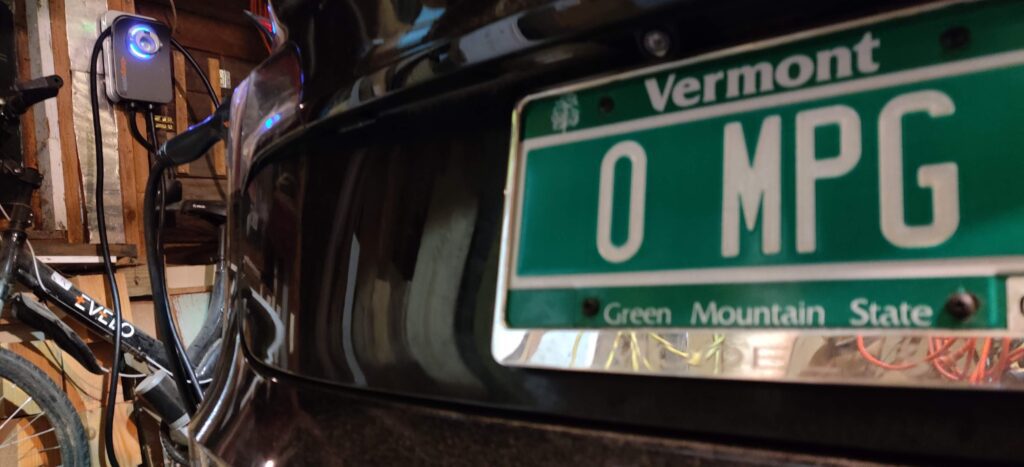Members Write
by Lauri Scharf

It’s been over two years now since we bought an electric car (or EV). It’s our first EV, so we weren’t sure what to expect, but at this point the verdict is in: we’re very satisfied. At the end of the day, living with an EV isn’t very different from daily life with a gas car. The vast majority of our trips are to work, for shopping, and to other destinations within a 20-mile radius. That uses a small fraction of the car’s battery. When it needs charging, our charger (courtesy of WEC’s PowerShift program; more on that later) can top it off in a few hours overnight. We can go to Burlington and back without charging, and on trips to Boston, we stop to charge for 25 minutes in New Hampshire. In winter, the battery range does decrease by maybe a third (my rough estimate), so those longer trips require more charging time, but our typical daily life is unaffected. A side-benefit to traveling with an EV is that it has more storage space (ours has a “frunk” where the engine would be). Will we go for an extended road trip in it? Not at this point, given our limited time (as working stiffs). But it won’t be long before there are enough charging stations that charge super fast. Then it’ll be a no-brainer.
Prior to buying this car, we had kept an eye on the EV options, knowing one was in our future, but the ones we looked at had limited range, lacked all-wheel drive, or had small interiors. By 2019, the variety of EVs had expanded and we found a model that met enough of our needs, so we pulled the trigger. The federal tax credit was a big help. We still own a gas car that owes us nothing, but it spends more time parked in the driveway than our EV does.
Getting set up to charge the car at home was pretty straightforward. WEC’s Energy Coach provided us a ChargePoint unit under the PowerShift program, whose goal is to “shift” heavy usage like car charging and hot water heating to off-peak hours. We just paid an electrician to install it. (WEC put us in touch with the electrician, and his cost was less than half what another electrician quoted us!) Our car starts charging at midnight and is done by 3 or 4 a.m. (depending on how low the battery was to start, and how full we set it to get). The charger is on a 50 amp circuit but uses only 32 amps (or about 6 kW), which is plenty. Depending on the charger model, the EV, and your house’s electrical service, you can get plenty more than 6 kW, but we’re barely ever in such a rush (and it’s not great for the long-term health of the battery).
Maintaining our EV is simpler than a gas car; we swap the tires for winter, and we add windshield wiper fluid. With no engine (just an electric motor), there are no other fluids, oil, or belts to keep an eye on. The regenerative braking means that we use the brakes a lot less, so they last longer. Given that our car has only 30K miles, it’s not surprising that it’s been problem-free. I’m sure we’ll pay the piper at some point, just like with any car that suffers through Vermont winters and mud seasons.
Perhaps the most surprising thing I discovered was how much less energy it takes to move an EV than a gas car. The other day, I drove the EV to Sharon and back, a trip of 86 miles. My car reported it had used 31 kilowatt hours (kWh). A comparably-sized gas car might have used three gallons of gas. Those three gallons contain the equivalent of about 100 kWh, or three times what my EV used. Wow. According to AAA, a typical gas engine wastes two thirds of its energy in heat loss! This explains why the gas car requires three times the energy of an EV. (Of course there are some more efficient gas cars out there, but none get 86 miles to the gallon.) And those three gallons of burned gas emit 60 pounds of carbon dioxide. On the cost side, that Sharon trip set me back about $7 at current WEC rates. Three gallons of gas these days will run you around $10.

This was the first new car we’d bought in 25 years, so it took some time for us to come around to the idea of spending $36,000 (after taxes and delivery). But it’s now clear that it’s a car that works well and will work for us for years to come.
